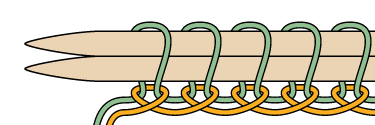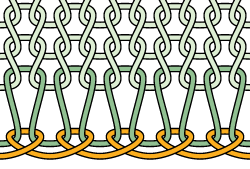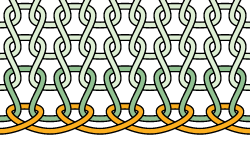What she said
By JC | November 4, 2011
Have you listened to the latest Knitcircus podcast? I have; I was the one nodding my head vigorously as Amy blasted open the myth that you can give a long-tail cast-on more “give” by working it over a larger needle, or over two needles held together.
Oh, not so, dear reader.
Lemme show you why. (Amy explains it perfectly well, but hey, I’m all about the pretty pictures.)
Consider a long-tail cast-on being worked in two colors: green for the yarn attached to the ball, and orange for the “tail” yarn (to match my favorite jumbotron yarn, of course). The green yarn forms the stitches; the orange secures each cast-on stitch by wrapping around its base.
If you hold two needles together, the green yarn loops around both of ’em:
This creates big, messy loops. You can see it even more clearly after knitting a few rows – shown here in light green:
Instead, just cast on over a single needle of the usual size:
This gives you cast-on stitches that match those in the rest of the fabric:
So doing a long-tail cast-on over a larger needle or over two needles is not the way to go. You can get a looser long-tail cast-on in a few different ways, but Amy describes a nice, simple method in the podcast: just space the stitches out on the needle as you cast on. It’s kind of like when you space stitches out on your right needle as you’re doing stranded colorwork, to keep the fabric from puckering.







2 Comments